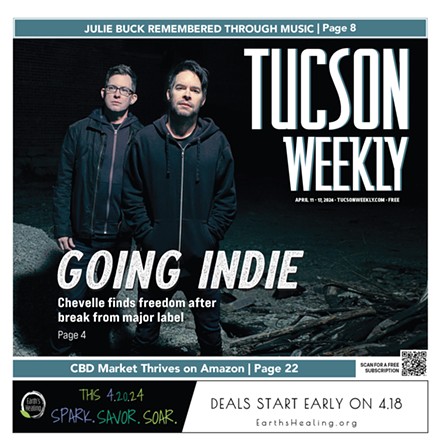I saw a rough cut of the film you'll be seeing this weekend--and you will be seeing it, assuming the city passes Ordinance R0c-K17, which states that "all Tucsonans must attend a screening of the aforementioned film, High and Dry, or be, like, way melvin." In the name of full disclosure, I should note that I know a number of the people featured in the film, as well as those who made it. But then, if you've lived in Tucson at any point in the last 20 years, and you weren't one of the residents who took their trailers to Michigan every summer so the grandkids could play at the lake, then you'll know some of these people, too.
Cinematographer Chris Wagganer (formerly of Tucson musical duo "Johnny Good Good Good Times and the Shit," which also featured a talentless local movie critic on electric slinky) is joined at lensing duties by Anna Lee Keefer, who shot legendary Tucson short feature Invisible World. Together with director Michael Toubassi, they've produced the definitive document on the development of the Tucson music scene from the late '70s to today.
Most of the film is dedicated to interviews with the stars and starmakers of a scene that, in truth, has no big stars, at least if you look at American music charts. But acts like Calexico, Giant Sand and Doo Rag are sought after for concert dates in Europe, which is like being big in Japan, only with a whole continent instead of a tiny island nation. Or, as Lucas Mosely, drummer/singer of Pork Torta put it, "In Europe, they treated us like we were legitimate artists ... it made me feel kinda weird."
High and Dry takes a mostly chronological tack, beginning with the local punk scene of the late '70s, when groups like Johnny Sevin, the Pedestrians, and The Pills played at Pearl's Hurricane, one of less than 30 punk clubs that existed in the nation. Pearl's was quickly supplemented by Tumbleweeds and the quasi-venue 818 House, which was really just punk musician/electronic genius David Forbes' house.
Forbes, who's interviewed here, is one of the great heroes of the Tucson music scene, not only for hosting the bands that no one else would show, but also for his alleged role in the alleged existence of alleged radio station "Radio Limbo," which may or may not have been the greatest radio station ever, if it did indeed or does indeed exist, which at this time I am not at liberty to say.
Forbes' sly semi-existence is emblematic of the Tucson scene, and it's something that Toubassi captures neatly: Tucson musicians are best when they lay low, because no one really makes it big out of Tucson. The near-miss stories of bands like Green on Red and The Sidewinders are emblematic, and make great cinema. There's even an incredibly embarrassing Sidewinders video from the '80s featuring wind-machine hair effects.
And, of course, there's the story of the Giant Sandworms, the band that spawned Giant Sand, and which featured the two godfathers of the desert rock sound: Howe Gelb and Rainer Ptacek.
Gelb gives great interview, and his reminiscences cover nearly the entirety of the Tucson scene and sound. With his movie-star good looks and local-legend status, it's kind of shocking that he never got scooped up by the celebrity machine, but it worked out great both for his music and for the musical health of the city.
On the other side of the desert-rock divide are the anti-desert-rock bands, two of which hit by abandoning all things Tucsonan. Machine of Loving Grace were briefly MTV darlings before they self-destructed, and the Supersuckers are generally thought of as a northwest band since they fled to Seattle just in time for the grunge explosion.
But the finest of the anti-desert rockers are Pork Torta and Doo Rag, who stayed true to the independent spirit and who provide some of the best moments in High and Dry. Doo Rag guitarist Bob Log III wears his trademark spaceman helmet throughout his sweaty interview, and Pork Torta's Lucas Mosely turns out to be just as good in front of a mic as he is behind the drums.
There are really too many fun elements of this film to describe in one short article, which is one of the few downsides to High and Dry: The cut I saw was just a little too long. But it's all good, and the only thing I'd change is to swap out a few interviews in favor of more concert footage.
What makes it so good is, in part, that it's like a home movie for the entire city of Tucson, and it's one you should really check out and support. There's something about local music that the nationally known bands can never have: Look, even if Britney Spears was the greatest musician in the world, you can't hang with her, can't go talk to her and can't learn from her. The joy of the local scene is the connection, and you're invited to become part of it. High and Dry is both a good intro to that scene (you're sure to see many of the stars at this week's screening) and a loving look back on it for those who are already involved. That's why you have to see it: not only because it's well done, well shot and full of interesting people, but because it shows that the local entertainment scene is every bit as good, and usually a lot better, than the alienated glitz that you normally see on your MTV.













